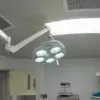Surgical lights play a critical role in modern treatment and significantly differ from conventional lighting in several key aspects. To comprehend why surgical lights are indispensable in operating rooms, let’s explore their unique characteristics and advantages.
Differences in Color Temperature and the Importance of ‘Whiteness’
Unlike standard lights, surgical lights must emit a high degree of ‘whiteness.’ This brightness level is crucial for surgeons who require the utmost clarity during procedures. Traditional lights fall short in providing this necessary’ whiteness,’ which is why halogen bulbs were previously favoured due to their superior brightness compared to conventional lighting.
The Significance of Light Colors and ‘Whiteness’
Surgeons need to differentiate various shades of flesh during surgery accurately. If the lighting casts red, blue, or green hues, it can lead to a misleading appearance of the patient’s tissues. Measured in kelvins, accurate colour perception is vital for patient safety and surgical precision.
Understanding Light Color Temperatures
Colour temperature is an indicator of how light appears. Lower Kelvin ratings produce a yellower light, often termed ‘warm white.’ In contrast, higher Kelvin ratings result in a ‘daylight’ or whiter light, preferable in surgical settings.
Issues with Heat and Radiation
Conventional lights can generate significant heat, mainly when focused on an area for long durations, as is common in extensive surgeries. This heat can cause thermal radiation, potentially drying out exposed tissues.
The Problem of Light Shadows
Shadows can adversely affect a surgeon’s perception and accuracy. While contour shadows can help distinguish tissue variations, contrast shadows are problematic, obscuring the surgeon’s view. Surgical lights often incorporate multiple light heads and bulbs to illuminate from various angles, reducing contrast shadows.
Evolution of Surgical Lights and Technology
In recent years, there’s been a shift from halogen to LED lights in operating rooms. Halogen lights, though effective, had limitations, including issues with shadow placement, tissue colour judgement, and heat production.
The LED Revolution in Surgical Lighting
LED technology has revolutionized surgical lighting. LEDs provide higher levels of ‘whiteness’ at lower temperatures than halogens. Being semiconductors, LEDs emit less heat, reducing the risk of drying out tissues. LED lights are more consistent in colour, avoiding the ‘yellow’ hue of halogens, and are more energy-efficient.
Cost-Effectiveness of LED Surgical Lights
LEDs are a cost-efficient choice for surgical lighting. They consume less electricity, produce less heat (requiring fewer precautions), have a longer lifespan, and are less prone to failure during power fluctuations than halogen lights.
Conclusion: Surgical Lights vs. Conventional Lights
Surgical lights meet specific requirements that regular lights cannot fulfill. While other forms of lighting provide brightness, they need to offer the quality and precision of light required in surgical settings. For those seeking advanced, efficient, and reliable surgical lighting solutions, ValleyMed offers state-of-the-art LED surgical lights. Their expertise and technology in the field ensure that medical professionals can perform surgeries with the highest level of visibility and safety.



